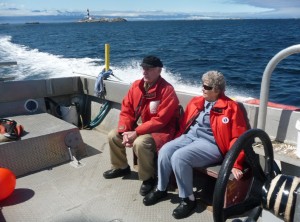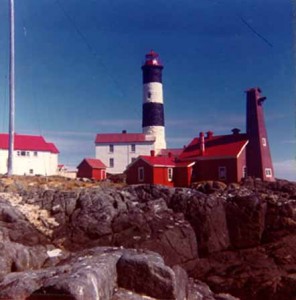 When Trev and Flo Anderson arrived at Race Rocks with their family in 1966, the old generator building was painted red and had a tall tower attached for the foghorn. By the mid-1970’s when we started coming out from Pearson College, the buildings were painted white. In 1978, the last of the wooden structures of the generator room were torn down and the present square block concrete building was erected.
When Trev and Flo Anderson arrived at Race Rocks with their family in 1966, the old generator building was painted red and had a tall tower attached for the foghorn. By the mid-1970’s when we started coming out from Pearson College, the buildings were painted white. In 1978, the last of the wooden structures of the generator room were torn down and the present square block concrete building was erected.
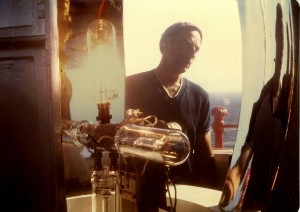 “When I first went over to Race Rocks in 1976, the light was made up of four 1000 watt bulbs, with one in the top position on at all times. When the bulb burnt out, it would automatically change positions with a new bulb. The light floated on a platform on a bath of mercury to reduce friction. Years later, Trev wonders how many light keepers were affected by the vapors given off from such mercury sources. In 1978, a beacon was installed that relied on more sophisticated electronics to send out a powerful beam . It wasn’t until after the Andersons left the station that the basin of mercury was replaced with a newer design with 8 beams. ( see lights file)
“When I first went over to Race Rocks in 1976, the light was made up of four 1000 watt bulbs, with one in the top position on at all times. When the bulb burnt out, it would automatically change positions with a new bulb. The light floated on a platform on a bath of mercury to reduce friction. Years later, Trev wonders how many light keepers were affected by the vapors given off from such mercury sources. In 1978, a beacon was installed that relied on more sophisticated electronics to send out a powerful beam . It wasn’t until after the Andersons left the station that the basin of mercury was replaced with a newer design with 8 beams. ( see lights file)
- This photograph published in the Times Colonist, (March, 2000), shows some architecture no longer present on the island: the tall fog-horn tower. The photo, taken by Gil Parker of Victoria shows the unique lines of the old engine room with the tower attached. Unfortunately this had to make way for modernization and was removed in 1977
- Demolition at Race Rocks: A film by Trev Anderson converted to digital video, showing the stone house originally built at the base of the tower and the wooden foghorn tower. Both were removed in the1960’s and 1970’s. This was taken before 1975 a view from the South side of the islands
- In 1977, Pearson College acquired a herring skiff for marine science and diving excursions. Here faculty members Garry Fletcher and John Wynne Hughes arrive at the island with students Charlie O’Neill and Andy Richmond on one of their earliest trips to the islands.
- We started to visit Race Rocks more frequently and the Andersons invited students to stay on project weeks. Andy and Bronwyn were among those who spent one such week on the island
- n 1977, PC students Alex, Edmond and Pierre were part of the group visiting on one occasion.
- In 1978, the herring skiff acquired a new fibreglass cabin , built by our Brazilian duo, Joao Luis and Anthony with help from many others. It was christened by them with the name “Ubatuba” after the beach of that name in Brazil meaning “big canoe” in a Northern Brazilian dialect
- Margaret, Kumene, Bartolomeo, Marta, Laurie and Soledad are a few of those recognized here
- Trev and Flo invited those of us who had worked so hard on the creation of the Ecological Reserve for Race Rocks in 1979 and 1980 to come to the island for the presentation of medals, ( I think it was “The Order of Race Rocks!”) Trev, Hans, Johan, Iina, Garry, Jens and Flo line up under the tower for this picture to mark that occasion.
- Trev and Flo helped us when the divers took local students from the public schools on our “Schools Project” field trips out to the Light Station.
- The many strips of wood which Trev glued together to make the hull
- A snow storm on the island, with winds from the North West.
- In one storm the plywood that was covering it blew away. It was for the Anderson’s a labor of love for the next seven years.
- Perseverance paid off, and in the spring of 1982, the “Wawa” was launched.
- If it had been durable enough to survive that, it would be a good bet to protect the Wawa as she was launched from that most precarious of locations into the seas of Race Passage. Building a 44 foot ketch by an amateur is hard enough on the mainland. Here, isolated on the rocks, it was even that much harder.
- After breaking the champagne bottle, Flo goes on board with Trev and no doubt could be heard to be saying “She does float after all!”
- The Red Ensign (coast guard version) which graced the bow had been the recognized Canadian flag until 1965. It was under this flag that Trev had served in the North African campaign with the RCAF on active service in the early 1940’s.
- Oded and Ricardo in the “banana boat” help tow the Wawa.
- Peter and others catch the lines as Wawa nears the docks
- Wawa in Pedder Bay
- After the fitting of the forward mast in Pedder Bay , the next stop was Vancouver for the fitting of the main mast.
- With masts and motor for full control, Wawa would return to Race Rocks for one last time to pick up the rest of Trev and Flo’s possessions that they would take with them aboard the boat.
- On their return to Pearson College, the Anderson’s spent many hours with our students aboard for shakedown cruises out of Pedder Bay.
- College director Jack Matthews accompanies the Andersons and students on one such outing.
- On one visit in the fall of 1982, Helen, Garry and Sarah Fletcher and Marc and Paul Marc Abrioux go out for a sail with Trev and Flo.
- Trev and Flo came by Taylor Beach for the year 3-4 ten year reunion in 1986. Marks McAvity, Anita and others were part of the group with the Wawa anchored off shore.
- Helen and Sarah talk to Trev and Flo on the docks at Pearson College.
- Flo Anderson has now written a book on their experiences entitled “Lighthouse Chronicles- Twenty Years on the BC Lights” See below for ordering information.
The book by Flo Anderson above is available from Harbour Publishing, P.O. Box 219 Madeira Park, B.C. V09-2H0
phone: 604-883-2730 fax: 604-883-9451 e-mail: harbour@sunshine.net To order direct from the publisher, pre-payment is required by cheque or Credit Card. GST for purchases in Canada, postage extra, No duty or GST in purchases from the US. Cost is $18.95(CAN)
 Link for this profile of Flo Anderson:
Link for this profile of Flo Anderson:
Flo Anderson was born in Victoria, B.C. She and her husband Trevor and their four children lived at five different B.C. lighthouse stations from 1961 to 1982. In December of 1961, her family left Vancouver to start life anew at the light station on Lennard Island, near Tofino. There wasn't a furnace. She used an old wood stove for heat and cooking, collecting driftwood for burning. She didn't meet anyone else on the island for weeks. "Writing about Lennard Island was very painful for me," she told interviewer Marianne Scott, "Life was traumatic. I was so naive. Recounting it all was therapy. Lots of people have this romantic view of living at a lighthouse. That's why I wrote about it." In 1963, Trevor Anderson became senior keeper at Barrett Rock, seven miles beyond Prince Rupert. Four months later they were sent to McInnes Island in Millbanke Sound, between Prince Rupert and Vancouver Island. Fourteen months later, they were relocated to northernmost staffed lighthouse in Canada, Green Island. In July of 1966 they were transferred to the southernmost point on the Canadian Pacific, Race Rocks, where they spent 16 years. As of 1974, they spent seven years building a yacht in whatever spare time they could find. "All the wives were part-time lighthouse keepers," she has recalled. "Unpaid, of course. It was just expected. When the man was away, the wife filled the gap." Trevor Anderson took early retirement in 1982, the year they launched their 44-foot wooden ketch, WaWa the Wayward Goose, circumnavigating Vancouver Island in 1983. For thirteen years they lived about their boat, once sailing as far as the South Pacific and New Zealand. Flo and Trevor Anderson came ashore in 1995 and now live in Sidney, B.C. At age 70 she wrote Lighthouse Chronicles: Twenty Years on the B.C. Lights (Harbour Publishing), published in 1988.
[BCBW 2003]
[BCBW WINTER 1998]
|
I In 2014 Trev and Flo celebrated their 70th wedding anniversary. At that time they still lived in Victoria BC. Flo Anderson passed away in 1997..https://www.racerocks.ca/flo-anderson-in-memoriam/ Trev celebrated his 100th birthday on October 22 , 2020 Trev had indicated that he had donated several artifacts from Race Rocks to the BC Maritime museum so we went in search of those items on May 22, 2014: |
Article in Pacific Yachting magazine by Marianne Scott on Trevor Anderson 2019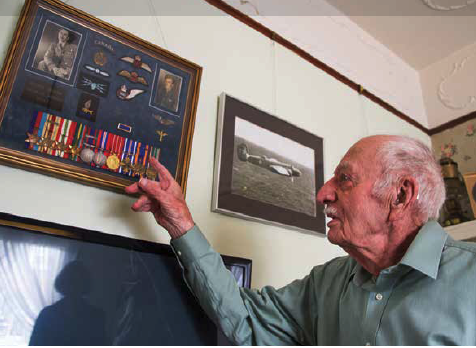



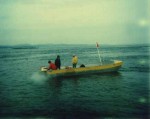
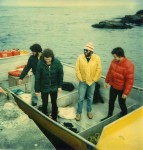
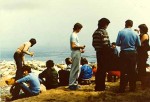
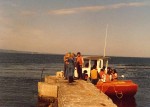
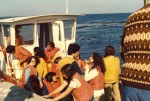

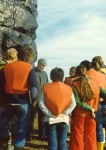

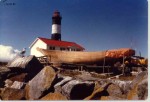


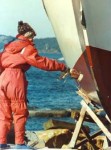

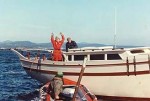
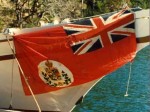
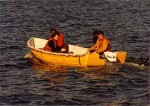


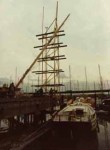


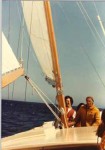
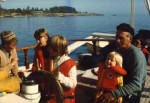
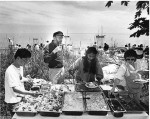

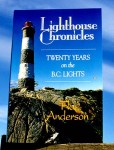
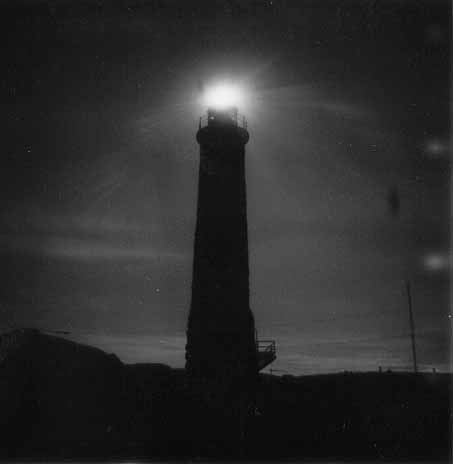
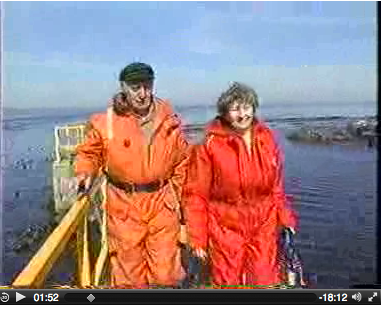 Trev and Flo return to Race Rocks for a visit and an
Trev and Flo return to Race Rocks for a visit and an